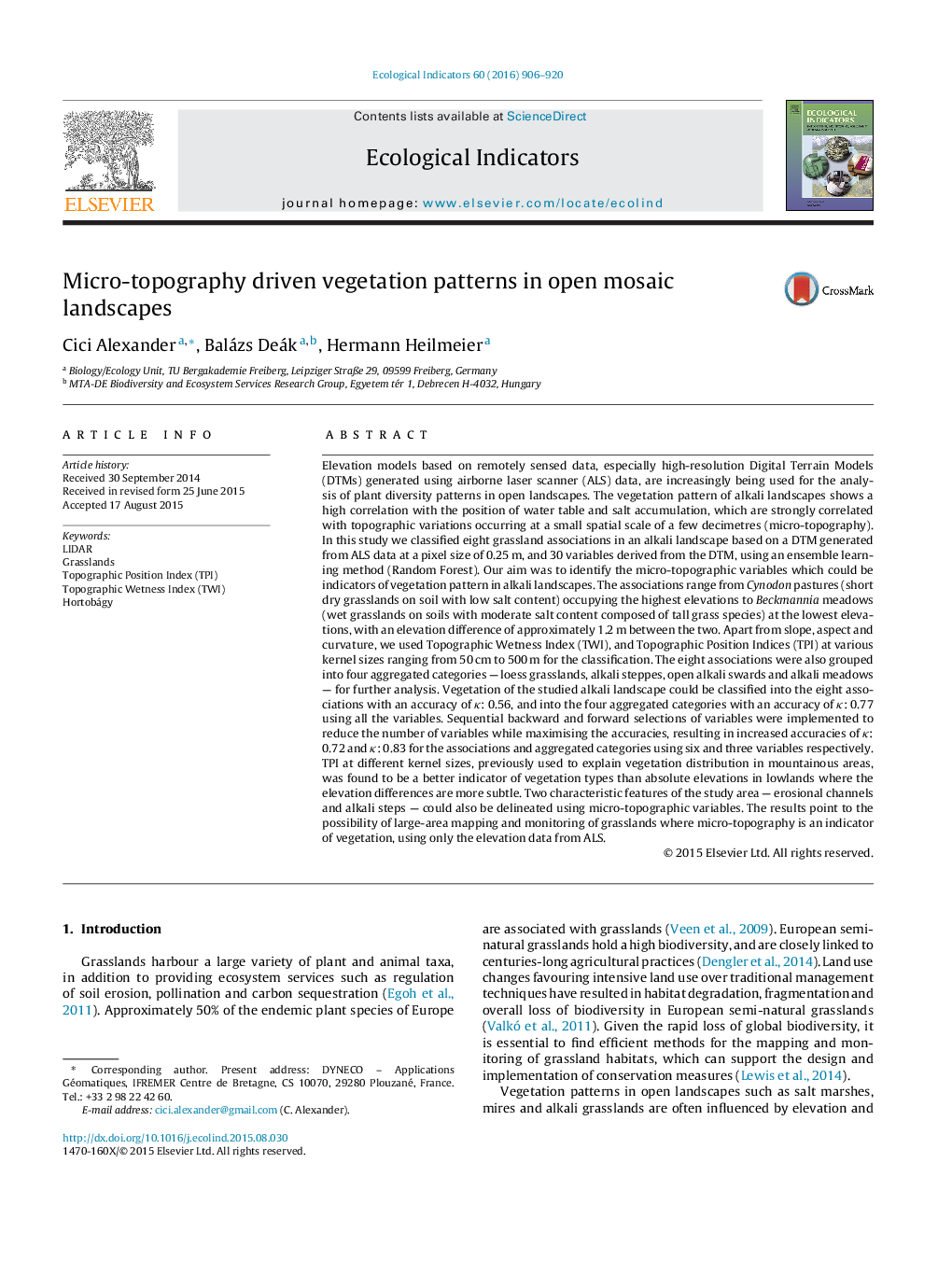| کد مقاله | کد نشریه | سال انتشار | مقاله انگلیسی | نسخه تمام متن |
|---|---|---|---|---|
| 6294189 | 1617141 | 2016 | 15 صفحه PDF | دانلود رایگان |
عنوان انگلیسی مقاله ISI
Micro-topography driven vegetation patterns in open mosaic landscapes
ترجمه فارسی عنوان
الگوهای پوشش گیاهی میکرو توپوگرافی در مناظر موزاییک باز
دانلود مقاله + سفارش ترجمه
دانلود مقاله ISI انگلیسی
رایگان برای ایرانیان
کلمات کلیدی
موضوعات مرتبط
علوم زیستی و بیوفناوری
علوم کشاورزی و بیولوژیک
بوم شناسی، تکامل، رفتار و سامانه شناسی
چکیده انگلیسی
Elevation models based on remotely sensed data, especially high-resolution Digital Terrain Models (DTMs) generated using airborne laser scanner (ALS) data, are increasingly being used for the analysis of plant diversity patterns in open landscapes. The vegetation pattern of alkali landscapes shows a high correlation with the position of water table and salt accumulation, which are strongly correlated with topographic variations occurring at a small spatial scale of a few decimetres (micro-topography). In this study we classified eight grassland associations in an alkali landscape based on a DTM generated from ALS data at a pixel size of 0.25 m, and 30 variables derived from the DTM, using an ensemble learning method (Random Forest). Our aim was to identify the micro-topographic variables which could be indicators of vegetation pattern in alkali landscapes. The associations range from Cynodon pastures (short dry grasslands on soil with low salt content) occupying the highest elevations to Beckmannia meadows (wet grasslands on soils with moderate salt content composed of tall grass species) at the lowest elevations, with an elevation difference of approximately 1.2 m between the two. Apart from slope, aspect and curvature, we used Topographic Wetness Index (TWI), and Topographic Position Indices (TPI) at various kernel sizes ranging from 50 cm to 500 m for the classification. The eight associations were also grouped into four aggregated categories - loess grasslands, alkali steppes, open alkali swards and alkali meadows - for further analysis. Vegetation of the studied alkali landscape could be classified into the eight associations with an accuracy of κ: 0.56, and into the four aggregated categories with an accuracy of κ: 0.77 using all the variables. Sequential backward and forward selections of variables were implemented to reduce the number of variables while maximising the accuracies, resulting in increased accuracies of κ: 0.72 and κ: 0.83 for the associations and aggregated categories using six and three variables respectively. TPI at different kernel sizes, previously used to explain vegetation distribution in mountainous areas, was found to be a better indicator of vegetation types than absolute elevations in lowlands where the elevation differences are more subtle. Two characteristic features of the study area - erosional channels and alkali steps - could also be delineated using micro-topographic variables. The results point to the possibility of large-area mapping and monitoring of grasslands where micro-topography is an indicator of vegetation, using only the elevation data from ALS.
ناشر
Database: Elsevier - ScienceDirect (ساینس دایرکت)
Journal: Ecological Indicators - Volume 60, January 2016, Pages 906-920
Journal: Ecological Indicators - Volume 60, January 2016, Pages 906-920
نویسندگان
Cici Alexander, Balázs Deák, Hermann Heilmeier,
